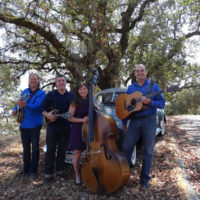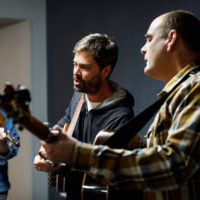
Marin County based, Mike Wilhoyte, is quite possibly the best California bluegrass guitarist and singer that you’ve never heard of. If so, then you haven’t been listening, because he’s played in loads of bands with high profile pickers, and seems to appear on the CBA Fathers Day stage every year with a different group. He’s even toured Australia. Mike and his family, spouse Karen and daughter Christine, always host a great camp and jam at the festivals. Mike is not one to boast and lets his music speak for itself, so it’s a pleasure and honor to get his story.
Thanks for your time, Mike. How did you come to bluegrass music?
My pleasure, Dave. I grew up in Toledo, Ohio. There was a large bluegrass community in northern Ohio and southern Michigan where many people from the south came to work in the auto industry. I got hooked on bluegrass when I was 13 years old after hearing someone play hammer-ons and pull-offs on the guitar. I’d been playing for about a year and was taking lessons. I asked the person what kind of music that was, and he said “bluegrass.” I took a bee-line back to the music store where I was taking lessons and begged to be taught this music. My instructor taught me Wildwood Flower, and I thought it was the greatest song in the world. When I turned 16 and could drive, I started going to a regular jam in Toledo. I put myself in the thick of it and never missed a jam for the next three years.
Was your family musical growing up?
My dad loved Roy Acuff and he would sing The Wreck on the Highway, and other songs. He didn’t play an instrument, but he loved country and bluegrass music. He grew up just outside of Louisville, Kentucky, and remembers hearing Bill Monroe play Mule Skinner Blues in 1942 on WSM. I got my first guitar from my uncle Robert Paul one Christmas while visiting family in Louisville.
What instruments do you play?
Just guitar. That’s all I’ve ever wanted to play.
There’s a lot of bluegrass talent in your immediate family. How did that happen?
My daughters have always listened to me either playing around the house or playing CDs in the car, so I’m happy to see Christine thriving in the community. She picked up the guitar when she was 14, instantly held the pick correctly, and I taught her the G-run. She picked up the banjo a year or two after that and plays more banjo now. I’m very happy for Christine and I’m glad I’m able to share that with her. My other daughter, Michelle, is more talented in art, but she enjoys coming to bluegrass events when she’s able. My wife, Karen, has been playing since I believe 2002, and bluegrass is what brought us together. We understand that bluegrass is not something you just like – it’s more of a lifestyle. We both enjoy this lifestyle and being a part of the community.
What’s the key to raising a child to be a musician?
Bring your kids to festivals so they’re exposed to the music, and they can meet and make friends with kids their own age. I’d also say don’t push them into it. If they want to play music, great, and then you support them in a healthy way.
You’ve played in a lot bands. Fill us in on the highlights.
I’ve played in a number of bands over the years, but to be honest, the highlights for me are having great friends and musicians to jam with. Bands are work and I never wanted to make music my living. I just enjoy making good music with quality people.
Which bands are still active?
Karen and I are members of a band that gigs every now and then called Lucky Drive with Eric Embry on banjo, Nicole Snider on mandolin, and Paul Shelasky on fiddle. It’s a fun band that plays a mix of old country duets and traditional bluegrass.
What players in those bands left the biggest impression on you?
Back in my early 20s I played in a band called Raisin River that had Tim Ellis on banjo, who played with Jim and Jesse, Jim Hurst on mandolin, and Larry Hurst on bass. Jim is known now more for his incredible guitar playing. I met Jim when I was 19 and he was a huge influence on my playing. Jim is a human metronome, and he helped straighten out a lot of my timing issues at the time. He also taught me a lot about harmony singing. The best singing I’ve heard to this day is Jim singing with his two brothers, Alvie and Larry.
You’ve played a lot of CBA events, haven’t you?
The Father’s Day festival is the highlight of the year for me. I’ve played this festival four or five times over the years, and it’s always a real honor to play on the main stage. I’ve played the main stage with Brushy Peak around 1992, Adobe Creek with Keith Little around 2003, and Blue and Lonesome in 2008 and 2015. I’ve also played Vern’s stage with Blue and Lonesome around 2005, with Lucky Drive in 2017, with Hydramatic Drive in 2018, and then with Tom Bekeny and the Bluegrass Buddies in 2019.
Who are your biggest musical influences?
I started out heavily influenced by Doc Watson when I was first learning to flat pick. Then I moved on to Clarence White and then, of course, Tony Rice. To be honest, I was more influenced by Tony’s rhythm playing than his lead playing. Jim Hurst was a big influence, as I mentioned earlier. When I wanted to learn how to sing and play good rhythm, I started listening to Jimmy Martin, Larry Sparks, Lester Flatt, Mac Wiseman, Red Allen, Carter and the Stanleys. I like the older stuff and players.
What recordings have you played on?
I’ve played on a few recordings from local bands in Toledo, but I doubt these are available. I’m on a recording that I did with a California band called Roanoke around 1997. I’ve also been on a few Blue and Lonesome recordings with Ed Neff. I haven’t recorded much, but it is something I’d love to do more.
What do you do when you are not playing music?
I enjoy being with my family. We have a little boy who’ll be two in April, so he keeps me busy. I enjoy working on old cars when I have time. I have two cars from my childhood, a 1950 Pontiac and a 1948 Olds. I also work as an electrical engineer.
Do you think there are connections between playing music and being an electrical engineer?
I don’t think so. Some people claim there’s a connection between a “math brain” and a musical brain. Music is more emotional for me – more right brain – at least that’s what I’m going for. When you’re first learning, you learn a lot of musical structures and building blocks, so that’s kinda mathematical I suppose. However when you’re performing, you want to forget all that stuff and rely on muscle memory and just feel the song.
What’s your routine when you first pick up your instrument each day?
I don’t really have a routine. I’ve been working on improving my right arm technique, so I may do a series of practice exercises in front of the mirror. If no one’s home, I’ll pull up Jimmy Martin or the Stanleys on the TV/YouTube and play along with it blasting.
What other artists do you listen to?
I like all the old brother duets like the Louvin Brothers and the Delmore Brothers. I’ve also been listening to Napier and Moore.
Bill Napier played mandolin with the Stanley Brothers, wrote Daybreak in Dixie, then moved to banjo and guitar with Charlie. Which Napier and Moore songs do you sing?
Bill was also a killer guitar player who did amazing cross picking. He and George Shuffler sounded very similar. I like singing the song Truck Driver’s Queen. I first heard Jimmy Martin’s version of this but soon discovered Moore and Napier’s, who in fact wrote the song. Jimmy even messed up the words so I’m glad to have learned this from the source. Bill is playing the cross picking guitar on the 1963 recording, which is fantastic.
Describe some musical challenges you’ve had and how you overcame them.
I feel like I’m always facing musical challenges. Generally speaking, if you want to play bluegrass, you have to spend a large portion of your time listening to the music to get the feel for it. It’s a good idea when you’re learning a song to record yourself and listen objectively. This can feel humiliating, but it’s very effective. It’s also a great idea to play to a metronome or with the original recording to get the timing and groove. Practice going from singing and playing rhythm to playing a lead and back again. One of the things I learned from Tony’s rhythm, back in my 20s, was how much he doesn’t play while singing. I soon discovered that many good players do this. It’s quite effective and creates space for backup instruments.
Can you expand on that statement that Tony doesn’t play while singing?
When you’re first learning rhythm, you play a basic strum pattern and you believe that’s what you need to do ALL the time. The problem is that this creates a “wall of sound” that’s constant and, frankly, saps the musicality from a song. Rhythm is an interactive sport that’s supposed to support what’s going on around you. While you or someone is singing, it’s best to back off and even leave out the strums and only play the bass notes for reference. During spaces, learn to swell when it makes sense. The trick is to learn to do this subconsciously and not think about it. Then you’re really playing and singing. All the greats do this – Tony, Lester, Del McCoury, Larry Sparks, etc. Take a listen!
How do you approach singing?
I find a key that fits my voice. I don’t try to sing in the keys on the original recordings if it’s too high for me. For example, Lester Flatt sang Footprints in the Snow in C, where Bill Monroe recorded it in E. I figure if C worked for Lester, it works for me. Next I try to sing a song until I think I’ve captured the feel for it.
Do you have any upcoming shows coming up?
No, but we’ll be at the Great 48 jam in Bakersfield!
For the geeks out there, what instruments do you have, play, and love?
I have a Sexauer Brazilian Rosewood dreadnought that I had custom built by Bruce Sexauer. I also have a Pre-War International HD that’s a great band guitar. Karen plays a Pre-War D18 model that I bought on a scotch-induced impulse. I love them all for different reasons.
Any final thoughts or things you want to share?
Just that I remember when I first came to California back in 1989, I was shut out of some jams and it made me feel bad. Karen and I enjoy having jams at our camp and we welcome everyone. I never want anyone to feel what I felt being shut out of a jam. We’re all on the same path, albeit some a bit further along than others. However if you set your sights on infinity, then we’re all about in the same spot.
Thanks for sharing your story Mike.
You’re welcome!
Thanks to copy editor Jeanie Poling.










